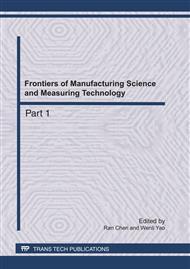[1]
C.A. Gracia-Fern´andez, S. G´omez-Barreiro, S. Ru´ız-Salvador, R. Blaine, Study of the degradation of a thermoset system using TGA and modulated TGA, Progress in Organic Coatings 54, p.332, (2005).
DOI: 10.1016/j.porgcoat.2005.08.002
Google Scholar
[2]
Biermann,U.,W. Friedt,S. Lang,W. Luhs,G. Machmuller J.O. Metzger M.R. Klass H.J. Schafer, and M.P. Schneider, New synthesis with oils and Fats as Renewable Raw Materials for the Chemical Industry, Angew. Chem. Int. Ed. Engl. 39, pp.2206-2224, (2000).
DOI: 10.1002/1521-3773(20000703)39:13<2206::aid-anie2206>3.0.co;2-p
Google Scholar
[3]
Pim-pahn Meyer, Niwat Techaphattana. Salamah Manundawee, Sasitorn Sangkeaw, Wannapit Junlakan, Chakrit Tongurai, Epoxidation of Soybean Oil and Jathropha Oil, Thammasat Int. J. Sc. Tech., Vol 13 Special edition, November (2008).
Google Scholar
[4]
Johannes T.P. Derksen,F. Petrus Cuperus, Peter Kolster, Paints and coatings from renewable resources, Industrial Crops and Products 3, pp.225-236, (1995).
DOI: 10.1016/0926-6690(94)00039-2
Google Scholar
[5]
F. Benard, B . Mailhot, J. Mallegol, J. LGardette, Photoageing of an electron beam cured polyurethane acrylate resin, Polymer degradation and thermal stability 93, pp.1122-1130, (2008).
DOI: 10.1016/j.polymdegradstab.2008.03.008
Google Scholar
[6]
Soo Jin Park, Fan-Long Jin, Jae-Rock Lee, Thermal and Mechanical properties of tetrafunctional epoxy resin toughened with epoxidised soybean oil, Materials Sciences and engineering A 374, pp.109-114, (2004).
DOI: 10.1016/j.msea.2004.01.002
Google Scholar
[7]
L. Barral, F. J. Diez, S. Garcia Garabal, J. Lopez, B. Montero, R. Montes, C. Ra mirez, M. Rico, Thermodegradation kinetic of a hybrid inorganic-organic epoxy system, European Polymer Journal 41, pp.1662-1666, (2005).
DOI: 10.1016/j.eurpolymj.2005.01.021
Google Scholar
[8]
Official methods and recommended Practices of the American Oil Chemists' Society, 3rd edn., American Oil Chemists'Society Campaign, (1980).
Google Scholar
[9]
S. Ma, J.O. Hill, S. Heng, A kinetic analysis of the pyrolysis of some australian coals bynon-isothermal thermogravimetry, J. Therm. Anal. 37, p.1161, (1991).
DOI: 10.1007/bf01913852
Google Scholar
[10]
H.E. Kissinger, Reaction Kinetics in Differential Thermal Analysis Anal. Chem. 29, p.1702–1706 , (1957).
DOI: 10.1021/ac60131a045
Google Scholar


